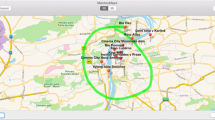Abstract
The paper presents an analysis of the multimodal interface model for the socially dependent people. The general requirements for the interface were to be as simple as possible and as natural as possible (in principle such interface should be the theoretical replacement of a typical “standard” one finger “joystick” control). Performed experiments allowed us to detect the most often used commands, the expected accuracy level for the selected applications and perform various usability tests.
Access this chapter
Tax calculation will be finalised at checkout
Purchases are for personal use only
Preview
Unable to display preview. Download preview PDF.
Similar content being viewed by others
References
Noyes, J.M.: Enhancing mobility through speech recognition technology. IEE Developments in Personal Systems, 4/1–4/3 (1995)
Pieraccini, M., Huerta, R.J.: Where do we go from here? Research and Commercial Spoken Dialog Systems. In: Proc. of 6th SIGdial Workshop on Discourse and Dialog, Lisbon, Portugal, pp. 1–10 (2005)
Acomb, K., et al.: Technical Support Dialog Systems, Issues, Problems, and Solutions. In: Proc. of the Workshop on Bridging the Gap: Academic and Industrial Research in Dialog Technologies, Rochester, New York, pp. 25–31 (2007)
Paek, T., Pieraccini, R.: Automating spoken dialogue management design using machine learning: An industry perspective. Speech Communication, Special Issue on Evaluating New Methods and Models for Advanced Speech-Based Interactive Systems 50(8-9), 716–729 (2008)
Valles, M., et al.: Multimodal environmental control system for elderly and disabled people. In: Proc. of Engineering in Medicine and Biology Society, Amsterdam, vol. 2, pp. 516–517 (1996)
Perry, M., et al.: Multimodal and ubiquitous computing systems: supporting independent-living older users. IEEE Transactions on Information Technology in Biomedicine 8(3), 258–270 (2004)
Wai, A.A.P., et al.: Situation-Aware Patient Monitoring in and around the Bed Using Multimodal Sensing Intelligence. In: Proc. of Intelligent Environments, Kuala Lampur, pp. 128–133 (2010)
Ishikawa, S.Y., et al.: Speech-activated text retrieval system for multimodal cellular phones. In: Proc. of Acoustics, Speech, and Signal Processing, vol. 1, pp. I-453–I-456 (2004)
Verstockt, S., et al.: Assistive smartphone for people with special needs: The Personal Social Assistant. In: Proc. of Human System Interactions, Catania, pp. 331–337 (2009)
Oviatt, S.: User-centered modeling for spoken language and multimodal interfaces. IEEE Multimedia 3(4), 26–35 (1996)
Deng, L., et al.: A speech-centric perspective for human-computer interface. In: Proc. of Multimedia Signal Processing 2002, pp. 263–267 (2002)
Zhao, Y.: Speech-recognition technology in health care and special-needs assistance (Life Sciences). Signal Processing Magazine 26(3), 87–90 (2009)
Sherwani, J., et al.: Speech vs. touch-tone: Telephony interfaces for information access by low literate users. In: Proceedings of Information and Communication Technologies and Development, Doha, pp. 447–457 (2009)
Motiwalla, L.F.: Jialun Qin. Enhancing Mobile Learning Using Speech Recognition Technologies: A Case Study. In: Management of eBusiness 2007, Toronto, pp. 18–25 (2007)
Sherwani, J., et al.: HealthLine: Speech-based Access to Health Information by Low-literate Users. In: Proc. of Information and Communication Technologies and Development, Bangalore, pp. 1–9 (2007)
Maskeliunas, R.: Modeling Aspects of Multimodal Lithuanian Human - Machine Interface. In: Esposito, A., Hussain, A., Marinaro, M., Martone, R. (eds.) Multimodal Signals, COST Seminar 2008. LNCS (LNAI), vol. 5398, pp. 75–82. Springer, Heidelberg (2009)
Author information
Authors and Affiliations
Editor information
Editors and Affiliations
Rights and permissions
Copyright information
© 2011 Springer-Verlag Berlin Heidelberg
About this paper
Cite this paper
Maskeliunas, R., Rudzionis, V. (2011). Multimodal Interface Model for Socially Dependent People. In: Esposito, A., Vinciarelli, A., Vicsi, K., Pelachaud, C., Nijholt, A. (eds) Analysis of Verbal and Nonverbal Communication and Enactment. The Processing Issues. Lecture Notes in Computer Science, vol 6800. Springer, Berlin, Heidelberg. https://doi.org/10.1007/978-3-642-25775-9_11
Download citation
DOI: https://doi.org/10.1007/978-3-642-25775-9_11
Publisher Name: Springer, Berlin, Heidelberg
Print ISBN: 978-3-642-25774-2
Online ISBN: 978-3-642-25775-9
eBook Packages: Computer ScienceComputer Science (R0)




